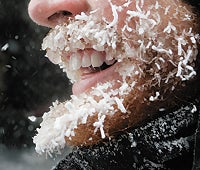How to Survive Winter Storms

When Neil Lareau first hiked New Hampshire’s Mt. Washington with his family 20 years ago, he encountered sideways rain and chowder-thick fog. Thus began his association with this infamous mountain and its volatile weather. Now employed at the summit observatory, the 26-year-old repairs anemometers in 130-mph winds and spends his off-days hiking nearby ridges. Ready yourself for Mother Nature’s meanest mood swings with Lareau’s advice on how to survive the world’s worst weather.
Focus your forecast Most weather reports don’t apply to backcountry or mountainous terrain, says Lareau. Gather specific information by calling ranger stations, checking guide books, and researching monthly climate trends. National park websites provide forecasts under the “Plan Your Visit” menu, and some high peaks have climbing forecasts, including Mt. Rainier (www.atmos.washington.edu/data/rainier_report.html) and Grand Teton (mountainweather.com).
Save your senses A headlamp in thick fog only makes the swirling clouds more opaque. Strap the light to your waist or thigh and focus the beam on the ground, says Lareau.
Survey the land Because terrain can both intensify or deflect severe weather, analyze local topography before heading out to choose the most protected routes. For every 1,000-foot gain in elevation, the temperature generally drops by 5°F.
Predict bad exposure Look for clues in the landscape–blowing spindrift or weather-beaten krummholz trees–indicating that a ridge or trail is becoming more exposed. Stop in a sheltered location to add protective layers before you get there.